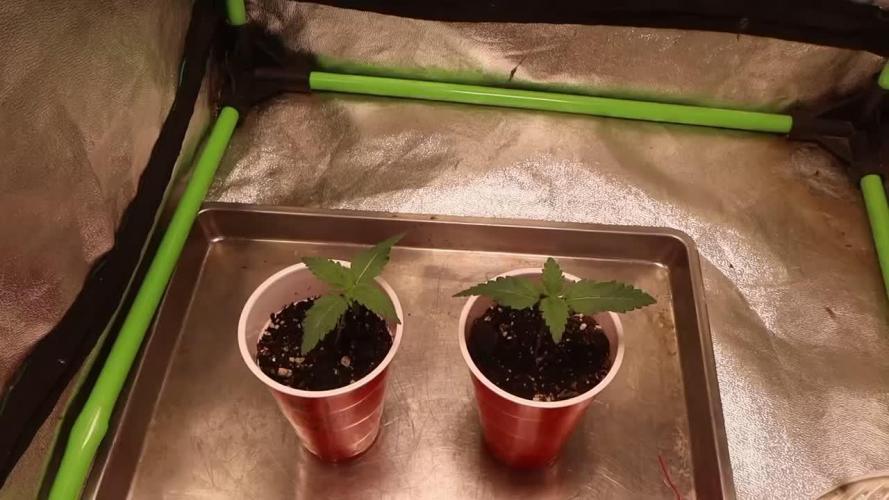By continuing to use the website or clicking Accept you consent to our cookies and personal data policy and confirm that you are at least 18 year old. For details please see Privacy Policy and Terms
Accept
Likes
Comments
Share


@BlackBear833
Follow
Same light schedule and still giving it only water but the plants look green and healthy no issues yet. Check out my YouTube video: https://m.youtube.com/watch?v=J2F-QjG2khs
Likes
5
Share


@weedelicious
Follow
Day 64:
I've been on vacation for four days now. However, I was able to keep an eye on everything remotely using the spiderfarmer app. They look great. The Pink Cookies and the Purple Kush have grown quite a bit taller. The buds have generally grown larger and the first frost is visible. I watered all the plants with 2 liters of water mixed with fertilizer and Cal Mag. More shoots have also woven into the web.
Likes
8
Share


@Hiroots420
Follow
14-05-2021 (DAY 59)
Se realizó el cambio de solución.
Las plantas vienen espléndidas y con el Safe roots de Hydrotek ya no tuve mas problemas de raíces.
Está entrando la flora mas potente y formándose los Buds.
Likes
16
Share


@Green_DSL
Follow
Week 5 flowering (a week is 5 days)
I lowered the longer branches trying to give as more light as possible to the plants, correct some top branches direction and defoliate a little bit.
Both plants keep developing some beautiful flowers with beautiful hairs and trichomes on buds and leaves. This week I started using Overdrive in my feeding blend.
Advanced Nutrients for coco professional program (I calculated EC of every single nutrient and made a custom dosage program for every week according to a more realistic EC value - check nutrients in my diary).
Plants are doing well, leaves are beautifully green without signs of nutrients burns, excess or deficiencies.
They are watered every day in the morning with fertilized water.
My daily routine is to correct the training of the branches, removing unwanted popcorn/bottom growth and removing leaves that covers buds and leaves that don’t perform well (i.e.: leaves at the bottom that will not take light).
🌱
Likes
18
Share


@DreamIT
Follow
Sponsored by:
🌴SPLIFF SEEDS🌴-💡VIPARSPECTRA💡-💐GREEN BUZZ LIQUIDS💐-🛠️WEDRYER🛠️
28/7 almost ready to go into bloom. They perform well and grow even better. we will see how they behave at the switch
2/8 it took a few days of absence to discolor the leaves and dry out the soil. Today I will be watering properly with Green buzz nutrients fertilizers before sending them into bloom
__________________________________________
Personal advertising (contains affiliate links)
__________________________________________
🦄 Are you new to the world of cultivation and don't know where to safely buy your seeds?
Fast and anonymous shipping. Check out their hilarious graphics. (no affiliate links)
✅https: //bit.ly/spliffseeds_
__________________________________________
Did you know that Green Buzz Liquids fertilizers are 100% vegan? A complete line of products ready to give the best to each of your plants! Visit the site and see my journals to see how they work 🦄
🤯 And with the code "dreamit" you will immediately receive a 15% discount on your purchases
✅https: //bit.ly/GreenBuzzLiquidsPro
__________________________________________
👀 Are you looking for a good lamp to start with? 👀
🌞Viparspectra has something more than the others, take a look at their site.
⏩ Use "GDVIP" for an extra discount or "DREAMIT3" for an extra 5 %% discount
👀 Search for it on Amazon
✅Amazon USA: https://amzn.to/30xSTVq
✅Amazon Canada: https://amzn.to/38udUVe
✅Viparspectra UE: bit.ly/ViparspectraUE
✅Viparspectra USA: bit.ly/ViparspectraUS
______________________________________________
🌈 Tired of blowing on your weed hoping it dries quickly? Check out the Wedryer website! You will find a well-made accessory that will help your weed dry in just 8-10 days without the annoying risk of finding mold or other annoyances! (no affiliate links)
✅https: //bit.ly/Wedryer_
______________________________________________
📷🥇Follow the best photos on Instagram 🥇📷
https://www.instagram.com/dreamit420/
Backup
https://www.instagram.com/dreamit4200/
🔻🔻Leave a comment with your opinion if you pass by here🔻🔻
🤟🦄💚 Thank you and good growth 💚🦄🤟
Likes
19
Share


@Dunk_Junk
Follow
Finally some decent growth!! 19cm this week and she got a lot bushier.
Not in flowering yet but that's ok, she needs to grow more ideally.
For nutrients I'm using 15g of 20-20-20 mixed with 10L of water. Also added 4ml/L of both Cannazym and Terpinator. This brings it to around 1600ppm including ~300ppm for my clean water.
Timelapse Sequence:
Pineapple Express
Blue Dream
*** Auto Jack (Not in shot) *** 😭
Pineapple Express
CBD Compassion
Likes
61
Share


@Amaya
Follow
Аляска сильно выросла за неделю, почти достала макушками до ламп.
В боксе очень влажно, для профилактики образования плесени опрыскала фитоспорином.
Likes
209
Share


@BioBuds
Follow
This week I defoliated. Waited three weeks into flowering, to not stress them like I did last grow. She is rewarding me with some fat bud growth at many sites. I overwatered beginning of this week, but hey seemed to have taken it well.
I did another amendment. The first one last week was a test, to see how they responded, they took it well. Just compare last week to this one.
The amendment I did:
- 5 liters of worm castings
- 2 cups bonemeal
- 1 cup wood ash
- 1 cup microlife
I layered this on top of my pots, covering this with bio-coco (pre fertilized) to ward of gnats. The gnats have been getting less and less. They don't like the coco that much, while humidity is just the same and last week higher since I did some more watering.
I watered with the perma tea. While this is pretty acidic (PH 5), I can amend with more wood-ash, if you don't and follow this recipe, don't do too much wood-ash since it will kill off your micro organisms.
I lowered the light diagonally since the outer right plant is longer and closer to it. The SP 3000 is still performing as you can see. Temps were a bit higher with the lights so low, so far the Orange Hill Special doesn't seem to mind. Im totally amazed with the results so far.
Look for the great end of year deals at www.mars-hydro.com.
Thank you for checking in on me again!
Hug Bud
Likes
7
Share


@CURATI_DA_SOLO
Follow
Questa pianta e veramente profumata di fragola cazzo!! E la prima volta che sento una varietà così profumata é ricoperta di tricomi OVUNQUE al momento sono tra il trasparente e il bianco latte, ho cambiato big Bud con overdrive per vedere di ingrossarle un po' di più, ho diminuito il grow aumentato il factor X vediamo cosa ne esce fuori! Comunque fast buds non smette mai di sorprendermi!!! Io coltiverò per tutta la vita solo le loro varietà!!! 😂 Non sono mai stato deluso dalle loro genetiche promettono quello che dicono e a volte anche di più!!!
Likes
33
Share


@Dapper_Buds
Follow
What’s going on lady’s an gentleman. GSC auto is going on w/8 an is killing in bud production! Had slight cal/mag issue got that fixed using roots organic cal+mag @1.5 tbs in a gallon of water an top feed. Rest of the week she got bottom feed. She is currently closer to the light an getting 49 DLI, RH@55%, Day temp is 81-82 degrees. Night temps is drop to 70-71 degrees. Other then that I’m stoked to see this girl finish she about a week or two out. An sofar just slaying it. That about all for this week Happy growing everyone an happy holidays
Likes
3
Share


@Margoulin
Follow
2/04
Very nice strain by Weed seed shop, first time 100% indoor. Growed Fems and Autos outdoor from their bank few times in the past, and it was also nice.
Loved the colours, very homogeneous plant.
Manicure made just before the harvest
I will weight flowers after drying, before curing and add infos and photos
Likes
26
Share


@Nistnov
Follow
I left the honey cream outside in a dark place, which turned out to be a big mistake.
None of the branches that I trimmed and dried directly had bud rot but around 6 buds that were left outside had bud rot.
The mass of this plant really put me to the test took a whole lot of time to trim every branch. In fact I still have a bunch of branches that I'm too lazy to trim right now so I'll do a dry trim someday.
Although this grow had some problems it was an absolute pleasure to watch these plants grow and to now having this harvest is absolutely beautiful, a perfect strain mix.
I won't ever let them grow this big again since I really don't need that much weed and I think I'll going to have more fun with some extreme LST or something like it and I guess I'll look for strains that will flower earlier and not for ones that flower fast.




































